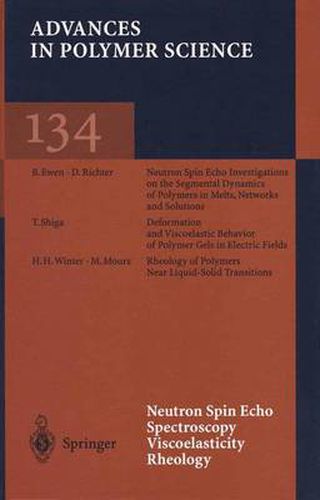Neutron Spin Echo Spectroscopy Viscoelasticity Rheology

Neutron Spin Echo Spectroscopy Viscoelasticity Rheology
This title is printed to order. This book may have been self-published. If so, we cannot guarantee the quality of the content. In the main most books will have gone through the editing process however some may not. We therefore suggest that you be aware of this before ordering this book. If in doubt check either the author or publisher’s details as we are unable to accept any returns unless they are faulty. Please contact us if you have any questions.
Viscoelasticandtransportpropertiesofpolymersintheliquid(solution,melt)or liquid-like (rubber) state determine their processing and application to a large extent and are of basic physical interest [1-3]. An understanding of these dynamic properties at a molecular level, therefore, is of great importance. However,thisunderstandingiscomplicatedbythefactsthatdi?erentmotional processes may occur on di?erent length scales and that the dynamics are governed by universal chain properties as well as by the special chemical structure of the monomer units [4,5]. The earliest and simplest approach in this direction starts from Langevin equations with solutions comprising a spectrum of relaxation modes [1-4]. Special features are the incorporation of entropic forces (Rouse model, [6]) which relax uctuations of reduced entropy, and of hydrodynamic interactions (Zimm model, [7]) which couple segmental motions via long-range back ow elds in polymer solutions, and the inclusion of topological constraints or entanglements (reptation or tube model, [8-10]) which are mutually imposed within a dense ensemble of chains. Another approach, neglecting the details of the chemical structure and concentratingontheuniversalelementsofchainrelaxation,isbasedondynamic scalingconsiderations[4,11].Inparticularinpolymersolutions,thisapproach o?ers an elegant tool to specify the general trends of polymer dynamics, although it su?ers from the lack of a molecular interpretation. A real test of these theoretical approaches requires microscopic methods, which simultaneously give direct access to the space and time evolution of the segmental di?usion. Here, quasi-elastic scattering methods play a crucial role sincetheyallowthemeasurementofthecorrespondingcorrelationfunctions.In particular,thehigh-resolutionneutronspinecho(NSE)spectroscopy[12-15]is very suitable for such investigations since this method covers an appropriate range in time (0.005)t/ns)40) and space (r/nm [15). Furthermore, the possibilityoflabellingbyhydrogen-deuteriumexchangeallowstheobservation of single-chain behavior even in the melt.
This item is not currently in-stock. It can be ordered online and is expected to ship in 7-14 days
Our stock data is updated periodically, and availability may change throughout the day for in-demand items. Please call the relevant shop for the most current stock information. Prices are subject to change without notice.
Sign in or become a Readings Member to add this title to a wishlist.


